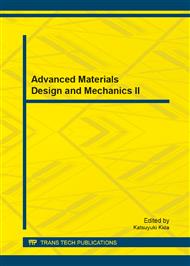[1]
T. Isobe, Kameshima, Y., Nakjima, A., Okada, K., Hotta, Y, Gas permeability and mechanical properties of porous alumina ceramics with undirectly aligned pores, Journal of the European Ceramic Society, 27(2007) 53-59.
DOI: 10.1016/j.jeurceramsoc.2006.02.030
Google Scholar
[2]
S. Jones, Improved Sol Based ceramic mould for the use in investment casting, Ph. D(1993), University Of Birmingham, Egbaston, UK.
Google Scholar
[3]
Zawati Harun, David Gethin, Drying(Consolidation) Porous Ceramic By considering the microscopic pore temperature gradient, Applied Mechanics and Materials, 147 (2012) 210-214.
DOI: 10.4028/www.scientific.net/amm.147.210
Google Scholar
[4]
M. M. A. Rafique, J. Iqbal, Modeling and simulation of heat transfer phenomena during investment casting, International Journal of Heat and Mass Transfer, 52(2009) 2132-2139.
DOI: 10.1016/j.ijheatmasstransfer.2008.11.007
Google Scholar
[5]
S. Amira, D. Dube, R. Tremblay, Method to determine hot permeability and strength of ceramic shell moulds, Journal of Materials Processing Technology, 211(2011) 1336-1340.
DOI: 10.1016/j.jmatprotec.2011.03.002
Google Scholar
[6]
Zawati Harun, D.T. Gethin, Drying Simulation of Ceramic Shell Build up Process, Second Asia International Conference on Modelling and Simulation (AMS 2008), 13-15 May, Kuala Lumpur, (2008).
DOI: 10.1109/ams.2008.109
Google Scholar
[7]
Zawati Harun, Nazri Mohd Nawi, Mohd Faizal Batcha1and David Gethin, Modeling of Layering Ceramic Shell Mould, Applied Mechanics and Materials. 232 (2012) 548-552.
DOI: 10.4028/www.scientific.net/amm.232.548
Google Scholar
[8]
C. Yuan, S. Jones., Investigation of fibre modified ceramic moulds dor investment casting, Journal of the European Ceramic Society, 23(2003) 399-407.
DOI: 10.1016/s0955-2219(02)00153-x
Google Scholar
[9]
R. V. Krishnarao, J. Subrahmanyam, T.J. Kumar, Studies on the formation of black particles in rice husk silica ash, Journal of the European Ceramic Society, 21(2000) 99-104.
DOI: 10.1016/s0955-2219(00)00170-9
Google Scholar
[10]
Z. Harun, N. H. Kamarudin, N. A. Badarulzaman, Shell mould composite with rice husk, Key Engineering Materials, 471-472 (2011) 922-927.
DOI: 10.4028/www.scientific.net/kem.471-472.922
Google Scholar
[11]
B. S. Ndazi, S. Karlsson, J.V. Tesha, C.W. Nyahumwa, Chemical and physical modifications of rice husks for use as composite panels, Composites: Part A 38(2007) 925-935.
DOI: 10.1016/j.compositesa.2006.07.004
Google Scholar
[12]
A. Bismarck, S. Mishra, T. Lampke, Plant fibers as Reinforcement for Green Composites, in Natural Fibers, Biopolymers and Biocomposites, United States: Taylor & Francis Group, (2005).
DOI: 10.1201/9780203508206.ch2
Google Scholar
[13]
A. A. R. M. Mokhtar, A. Hassan, Characterization and treatments of pineapple leaf fibre thermoplastic composite for construction application, Universiti Teknologi Malaysia, Johor, (2007).
Google Scholar
[14]
S. L. Favaro, M. S. Lopes, A. G. V. D. C. Neto, R. R. D. Santana, E. Radovanovic, Chemical, morphological, and mechanical analysis of rice husk/post-consumer polyethylene composites, Composites: Part A, 41(21010) 154-160.
DOI: 10.1016/j.compositesa.2009.09.021
Google Scholar
[15]
M. N. Rahman, Ceramic Processing and Sintering, 2nd ed., Taylor & Francis, (2005).
Google Scholar
[16]
S. Somiya, F. Aldinger, N. Claussen, R.M. Spriggs, K. Uchino, K. Koumoto, M. Kaneno, Handbook of Advanced Ceramics vol. Mater. Sci., (2003).
DOI: 10.1016/b978-012654640-8/50000-6
Google Scholar
[17]
S. Chuayjuljit, Eimnoh, S., Potiyaraj, P., Using Silica from Rice Husk as a Reinforcing Filler in Natural Rubber, J. Sci. Res. Chula. Univ, vol. 26, pp.127-137, (2001).
Google Scholar
[18]
Zawati Harun, Nur Farhani Ismail, Nur Azam Badarulzaman , Effect of MgO Additive on Microstructure of Al2O3, Advanced Materials Research, 488 - 489 (2012) 335-339.
DOI: 10.4028/www.scientific.net/amr.488-489.335
Google Scholar


